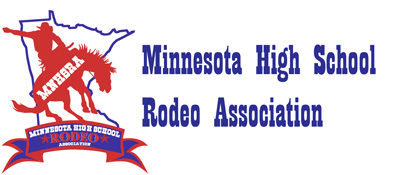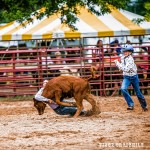Queen Contest (HS Girls)
 The NHSRA Queen Contest is a competition for the girls of each state and province in the National High School Association. To qualify for the National High School Finals Rodeo competition, contestants must be the winners of their state/provincial queen contest and chosen to represent that state/province and must meet other eligibility requirements. Girls who have just completed their senior year in high school are not eligible. The NHSRA Queen is selected based on her judged performance in these eight categories: Modeling,
The NHSRA Queen Contest is a competition for the girls of each state and province in the National High School Association. To qualify for the National High School Finals Rodeo competition, contestants must be the winners of their state/provincial queen contest and chosen to represent that state/province and must meet other eligibility requirements. Girls who have just completed their senior year in high school are not eligible. The NHSRA Queen is selected based on her judged performance in these eight categories: Modeling,
Personality, Appearance, Personal Interview, Prepared Speech, Impromptu Speech, Written Test, and Horsemanship. Any girl interested in the Queen Contest should contact the Queen Coordinator in the state or province in which they are a member. E-mail the NHSRA at info@NHSRA.org for the address and phone number of your state/provincial queen coordinator. For further information on the National Queen Contest please contact the NHSRA National Headquarters at 1-800-46-NHSRA.
Bareback Riding (HS Boys)
 To score well in this event, the rider must maintain balance, rhythm, and control, while at the same time spurring vertically above his head and horizontally away from the animal, with the follow-through of each spurring lick up the neck and shoulders of the horse. Broncs are scored for high kicking action, power - how hard they kick, lunge, and hit the ground changing direction, and rolling and twisting. Judges stand on either side of the chute and the first thing they look for is whether the rider's feet are over the point of the horse's shoulders when the animal's front feet hit the ground on the first jump out of the chute. Each judge will mark one side, using a span of 1 to 25 points each for horse and rider. The four marks will be totaled for the score: 100 points would be the perfect bareback ride. Horses will be ridden eight seconds. Rider cannot touch horse with free hand.
To score well in this event, the rider must maintain balance, rhythm, and control, while at the same time spurring vertically above his head and horizontally away from the animal, with the follow-through of each spurring lick up the neck and shoulders of the horse. Broncs are scored for high kicking action, power - how hard they kick, lunge, and hit the ground changing direction, and rolling and twisting. Judges stand on either side of the chute and the first thing they look for is whether the rider's feet are over the point of the horse's shoulders when the animal's front feet hit the ground on the first jump out of the chute. Each judge will mark one side, using a span of 1 to 25 points each for horse and rider. The four marks will be totaled for the score: 100 points would be the perfect bareback ride. Horses will be ridden eight seconds. Rider cannot touch horse with free hand.
Bareback Steer Riding (JH Boys)
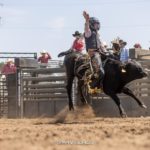
Like Bareback Riding for JH contestants steers are used instead of horses for 6 sec.
Pole Bending (HS Girls & JH Girls)
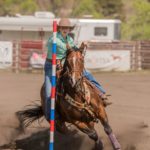 Pole bending pattern is to be run around six poles positioned in a straight line. Each pole is to be twenty-one feet apart and the first pole is to be twenty-one feet from the starting line. Starting either to the right or left of the first pole, rider runs course pattern. Five- second fine for each pole knocked over. No two girls may ride the same horse.
Pole bending pattern is to be run around six poles positioned in a straight line. Each pole is to be twenty-one feet apart and the first pole is to be twenty-one feet from the starting line. Starting either to the right or left of the first pole, rider runs course pattern. Five- second fine for each pole knocked over. No two girls may ride the same horse.
Steer Wrestling (HS Boys)
 The mounted steer wrestler is placed in a box behind a barrier; his hazer in a box on the opposite side of the steer. The steer must be given a head start. The contestant and his hazer overtake the steer at speeds up to 30 miles per hour. He starts to leave the saddle as his horse reaches the steer’s tail. The hazer is allowed only to keep the steer running in a straight line. As the steer wrestler drops over the steer, the horse carries him up to the steer’s head. He scoops the right horn in the crook of his right arm, and grasps the left horn in his left hand. The horse carries his feet out in front and at a slight angle for the best position to make the throw. Timing is critical the point is to turn the steer back instantly so that its own momentum aids in wrestling it to the ground.
The mounted steer wrestler is placed in a box behind a barrier; his hazer in a box on the opposite side of the steer. The steer must be given a head start. The contestant and his hazer overtake the steer at speeds up to 30 miles per hour. He starts to leave the saddle as his horse reaches the steer’s tail. The hazer is allowed only to keep the steer running in a straight line. As the steer wrestler drops over the steer, the horse carries him up to the steer’s head. He scoops the right horn in the crook of his right arm, and grasps the left horn in his left hand. The horse carries his feet out in front and at a slight angle for the best position to make the throw. Timing is critical the point is to turn the steer back instantly so that its own momentum aids in wrestling it to the ground.
Chute Dogging (JH Boys)
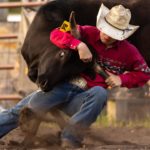 Is comparable to high school steer wrestling and begins in the bucking chute – not in the roping box. The contestant can get a partial hold on the steer inside the chute and then nods for the gate to open. The contestant cannot get into the throwing position until after the start line that is ten feet from the chutes. The throwing position is the left arm under the nose and the right arm around the right horn. If the contestant moved into the throwing position before the start line, there is a ten second penalty. If the steer is thrown before the start line, it results in a disqualified run.
Is comparable to high school steer wrestling and begins in the bucking chute – not in the roping box. The contestant can get a partial hold on the steer inside the chute and then nods for the gate to open. The contestant cannot get into the throwing position until after the start line that is ten feet from the chutes. The throwing position is the left arm under the nose and the right arm around the right horn. If the contestant moved into the throwing position before the start line, there is a ten second penalty. If the steer is thrown before the start line, it results in a disqualified run.
Goat Tying (HS Girls, JH Girls & JH Boys)
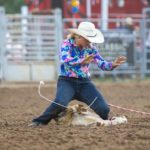 The goat is tied to a stake with a rope ten feet in length. Starting line will be 100 feet from the stake. Contestant must be mounted and ride from the starting line to the goat, dismount, throw the goat by hand and tie any three legs together with a leather thong or pigging string. If goat is down when roper reaches it, the goat must be elevated by roper so that at least three legs extend directly underneath before being thrown. Time is called when the roper stands back with hands raised. Judge waits six seconds to determine that the goat is securely tied. In Boy’s Goat Tying, the boy must use a pigging string and tie the goat like he would a calf – with one full wrap around the three legs and a hooey
The goat is tied to a stake with a rope ten feet in length. Starting line will be 100 feet from the stake. Contestant must be mounted and ride from the starting line to the goat, dismount, throw the goat by hand and tie any three legs together with a leather thong or pigging string. If goat is down when roper reaches it, the goat must be elevated by roper so that at least three legs extend directly underneath before being thrown. Time is called when the roper stands back with hands raised. Judge waits six seconds to determine that the goat is securely tied. In Boy’s Goat Tying, the boy must use a pigging string and tie the goat like he would a calf – with one full wrap around the three legs and a hooey
Saddle Bronc Riding (HS Boys)
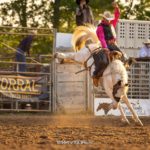 As in the other riding events, the two judges on either side of the chute each score the horse and rider on 1 to 25 point spreads, for a total possible 100 points. The saddle bronc, like the bare- back horse, is rated on how high he kicks, the strength and force of his bucking action, his reversed in direction, and for rolling and twisting action. For the control looked for by the judges, the saddle bronc rider’s spurring action must be exquisitely timed to the horse’s bucking rhythm. The more the rider turns out his toes, the more his spurs will drag in contact with the horse. Length of stroke from neck rearward to the back of the saddle also increases the rider’s score. Riding rein and hand must be on same side. To qualify, rider must have spurs over the break of the shoulders and touching horse when horse’s front feet hit the ground first jump out of the chute. Ride to be eight seconds. Rider will be disqualified for being bucked off; changing hands on rein; losing stirrup; or touching the animal, saddle or rein with free hand. The classic event of rodeo, an outstanding saddle bronc rider is a beautifully choreographed dance of man and wild horse pitted spirit to spirit in intense poetry in motion.
As in the other riding events, the two judges on either side of the chute each score the horse and rider on 1 to 25 point spreads, for a total possible 100 points. The saddle bronc, like the bare- back horse, is rated on how high he kicks, the strength and force of his bucking action, his reversed in direction, and for rolling and twisting action. For the control looked for by the judges, the saddle bronc rider’s spurring action must be exquisitely timed to the horse’s bucking rhythm. The more the rider turns out his toes, the more his spurs will drag in contact with the horse. Length of stroke from neck rearward to the back of the saddle also increases the rider’s score. Riding rein and hand must be on same side. To qualify, rider must have spurs over the break of the shoulders and touching horse when horse’s front feet hit the ground first jump out of the chute. Ride to be eight seconds. Rider will be disqualified for being bucked off; changing hands on rein; losing stirrup; or touching the animal, saddle or rein with free hand. The classic event of rodeo, an outstanding saddle bronc rider is a beautifully choreographed dance of man and wild horse pitted spirit to spirit in intense poetry in motion.
Saddle Steer Riding (JH Boys)
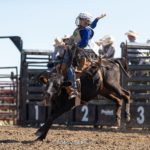
Like Saddle Bronc Riding for JH contestants steers are used instead of horses for 6 sec.
Tie-Down Roping (HS Boys & JH Boys)
 If cowboy intends to use two loops, two ropes must be carried. Catch as catch can. Cowboy must dismount, go down rope, throw calf by hand, and cross and tie any three feet. If calf is down when roper reaches it, he must allow calf to get up and then throw him. If roper’s hand is on calf when calf falls, calf is considered thrown by hand. The calf must stay tied for six seconds after the roper calls for time, and slacks the rope. There will be a ten-second fine for breaking the barrier. JH Boys must choose either tie down roping or Breakaway roping. Boys cannot compete in both events during a rodeo.
If cowboy intends to use two loops, two ropes must be carried. Catch as catch can. Cowboy must dismount, go down rope, throw calf by hand, and cross and tie any three feet. If calf is down when roper reaches it, he must allow calf to get up and then throw him. If roper’s hand is on calf when calf falls, calf is considered thrown by hand. The calf must stay tied for six seconds after the roper calls for time, and slacks the rope. There will be a ten-second fine for breaking the barrier. JH Boys must choose either tie down roping or Breakaway roping. Boys cannot compete in both events during a rodeo.
Breakaway Roping (HS Girls, JH Girls & JH Boys)
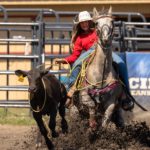 Two loops will be allowed if two ropes are carried. Each rope is tied to saddle horn with string. Rider, starting when the barrier drops, rides after the calf, throwing loop over its head. As rider pulls up her horse, the running calf breaks the string and the rope falls free from the saddle horn. A white flag must be attached to the rope at the saddle horn so judge can tell when rope breaks free. Time is called when judge drops his flag. Ropes must be released from contestants hand to be a legal catch. Horse must clear box before loop is thrown. A ten-second fine for broken barrier will be assessed.
Two loops will be allowed if two ropes are carried. Each rope is tied to saddle horn with string. Rider, starting when the barrier drops, rides after the calf, throwing loop over its head. As rider pulls up her horse, the running calf breaks the string and the rope falls free from the saddle horn. A white flag must be attached to the rope at the saddle horn so judge can tell when rope breaks free. Time is called when judge drops his flag. Ropes must be released from contestants hand to be a legal catch. Horse must clear box before loop is thrown. A ten-second fine for broken barrier will be assessed.
Ribbon Roping (JH Boys & JH Girls)
Ribbon roping is a unique event that involves a team consisting of a cowboy and cowgirl. Either gender can be the Roper or Runner. The calf rope is tied on hard-and-fast like in calf roping. After the calf is roped, the Roper gets off to help the Runner get the ribbon that is tied to the calf's tail. The Runner takes the ribbon and runs across the finish line which is 30 feet in front of the roping chute. The Roper must be touching the calf when the Runner removes the ribbon or it is a disqualified run.
Team Roping (HS Boys, HS Girls, JH Boys & JH Girls)
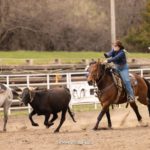
Team may be composed of two boys, two girls, or a boy and a girl. In dally team roping, ropes are loose from the saddle horns, and after making the catch, the ropers must take a wrap around the horn. Time is taken when both ropes are tight and both horses are facing the steer. There are strict rules defining a fair head catch. The rope must be around both horns, the neck, half a head. There is a five second penalty for catching only one hind foot. There is a ten-second penalty for breaking the barrier.
Barrel Racing (HS Girls & JH Girls)
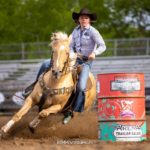
Contestant is allowed running start; time begins as soon as the horse’s nose reaches the starting line and is stopped when horse’s nose crosses the finish line. Contestant must run barrels in clover- leaf pattern, starting at either side. A five-second penalty for each barrel knocked down will be assessed. No two girls may ride the same horse.
Bull Riding (HS Boys & JH Boys)
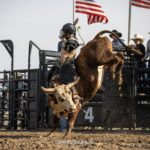 Riding to be done with one hand and loose rope, with bell attached. Bull is to be ridden eight seconds. A resined soft leather glove is worn on the hand the rider uses to grasp the bull rope. Only the squeeze of his hand on the handhold and the wrap of the rope's tail hold him to the bull. The bull rider's chaps, perhaps more than in any other event, afford protection against scrapes, stomps and bruises. His dull roweled spurs complete his equipment list. Each of the two judges scores a bull from 1 to 25 on how hard he bucks and kicks, whether he spins, and if he rolls and twists and changes directions during the ride. A high kicking spin is much more difficult for the rider than is a flat spin, and a change in direction in spin is a most difficult move for the rider to adjust to. The rider, on a similar point spread, is scored on his balance, timing, and most important, his degree of control. A bull rider is not required to spur the animal, as are bronc riders, but his score is higher if he does. Watch the motion of his free arm, for there is the key to balance in the ballet he performs on the bull's back.
Riding to be done with one hand and loose rope, with bell attached. Bull is to be ridden eight seconds. A resined soft leather glove is worn on the hand the rider uses to grasp the bull rope. Only the squeeze of his hand on the handhold and the wrap of the rope's tail hold him to the bull. The bull rider's chaps, perhaps more than in any other event, afford protection against scrapes, stomps and bruises. His dull roweled spurs complete his equipment list. Each of the two judges scores a bull from 1 to 25 on how hard he bucks and kicks, whether he spins, and if he rolls and twists and changes directions during the ride. A high kicking spin is much more difficult for the rider than is a flat spin, and a change in direction in spin is a most difficult move for the rider to adjust to. The rider, on a similar point spread, is scored on his balance, timing, and most important, his degree of control. A bull rider is not required to spur the animal, as are bronc riders, but his score is higher if he does. Watch the motion of his free arm, for there is the key to balance in the ballet he performs on the bull's back.
Cutting (HS Boys & HS Girls)
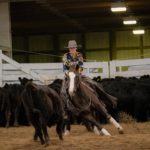 No choke ropes, tie downs, or wire around the horse's neck will be permitted. Horse must be ridden with a bridle (with bits in mouth and no noseband or bosal), or hackamore. Quirt or bat must not be carried. Time allotted each horse to work is 2 1/2 minutes. A judge marks from 60 to 80 points. Any rider who allows his horse to quit working or leaves the area before his allotted time is up will be disqualified for that go-round with no score. A horse will be given credit for his ability to enter a herd of cattle and bring one out with very little disturbance to the herd or the one brought out. The horse should never get ahead of the animal and duck it back toward the herd to get more play, but should let the turnback man tum it back to him. A horse will be penalized for the following: each time the back fence is used for tum-back purposes; each time he is reined or visibly cued in any manner; if an animal that he is working gets back into the herd; if additional cattle are picked up from the herd; if a horse quits a cow or must be restarted by his rider; and if a horse clears the herd with two or more cattle and fails to separate a single animal before quitting. If a horse turns the wrong way with tail toward animal being worked, he will be no score and disqualified for that go-round.
No choke ropes, tie downs, or wire around the horse's neck will be permitted. Horse must be ridden with a bridle (with bits in mouth and no noseband or bosal), or hackamore. Quirt or bat must not be carried. Time allotted each horse to work is 2 1/2 minutes. A judge marks from 60 to 80 points. Any rider who allows his horse to quit working or leaves the area before his allotted time is up will be disqualified for that go-round with no score. A horse will be given credit for his ability to enter a herd of cattle and bring one out with very little disturbance to the herd or the one brought out. The horse should never get ahead of the animal and duck it back toward the herd to get more play, but should let the turnback man tum it back to him. A horse will be penalized for the following: each time the back fence is used for tum-back purposes; each time he is reined or visibly cued in any manner; if an animal that he is working gets back into the herd; if additional cattle are picked up from the herd; if a horse quits a cow or must be restarted by his rider; and if a horse clears the herd with two or more cattle and fails to separate a single animal before quitting. If a horse turns the wrong way with tail toward animal being worked, he will be no score and disqualified for that go-round.
Reined Cow Horse (HS Boys & HS Girls)
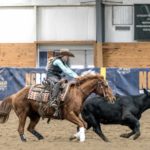
Reined cow horse is a type of competition where horses are asked to work a single live cow in an arena, performing specific maneuvers that include circling the cow, turning it in a specified manner, and performing a reining pattern. Competition consists of three parts where a horse and rider are judged on their performance in a reining pattern, herd work, and "fence work". Horses are judged on accuracy, timing, and responsiveness, as well as how they handle a single cow and their ability to ride into a herd of cattle and quietly "cut" a cow from the herd.
